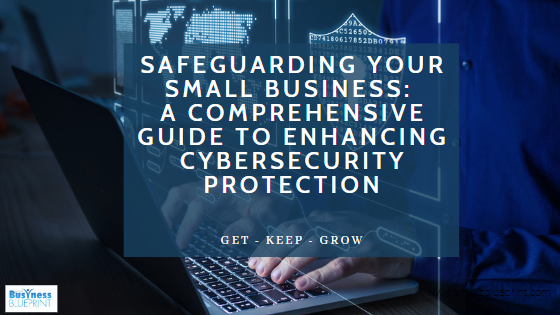In today’s digital world, cyberattacks can pose significant risks to your operations, customer data, and overall reputation.
To protect your business and safeguard your data, it is important to understand the cybersecurity threats and how to protect your business.
This guide will equip you with practical tips and effective strategies to enhance your cybersecurity protection, even on a limited budget.

Let’s see how you can protect your business against cyber threats!
Assess Your Current Cybersecurity Landscape: Understanding the Risks
Before you can protect your business, assessing your current cybersecurity landscape is crucial.
Identify potential vulnerabilities and risks to your digital assets, such as customer data, financial records, and intellectual property.
Conduct a thorough audit to uncover weak points that may make your business an attractive target.
Example: Imagine your small business is an online retail store that handles customer payment information. Your cybersecurity audit reveals outdated software, weak password protocols, and unencrypted data storage, exposing your business to potential breaches.
Establish Robust Password Policies: The Key to Digital Fortification
Establishing robust password policies is one of the simplest yet most effective ways to enhance cybersecurity.
Encourage employees to create strong, unique passwords and regularly update them.
Implement multi-factor authentication to add an extra layer of protection to sensitive accounts.
Example: Instead of using “Password123,” opt for a combination like “Cyb3r$3cur1ty!R0cks!” with uppercase and lowercase letters, numbers, and special characters.
Remember, strong passwords act as virtual fortresses against cyber threats.
Educate and Train Your Staff: Empowering Your First Line of Defense
Your employees play a critical role in cybersecurity.
Educate and train them on best practices, common threats, and warning signs of phishing emails or suspicious websites.
Encourage them to be vigilant and report any potential security incidents promptly.
Example: Conduct interactive training sessions or engage external cybersecurity experts to deliver engaging workshops. Provide real-world examples and case studies to illustrate the impact of cyber threats and empower your team to be proactive protectors of your business.

Implement Regular Software Updates: Shielding Against Vulnerabilities
Outdated software can leave your business exposed to cybersecurity risks.
Regularly update operating systems, applications, and plugins to ensure you have the latest security patches and bug fixes.
This practice reduces vulnerabilities and strengthens your defences.
Example: A recent study found that the notorious “WannaCry” ransomware targeted businesses that had not applied critical security updates. By keeping your software up to date, you can stay ahead of potential threats and protect your small business.
Secure Your Network: Building Digital Moats
Protecting your network is essential for small business cybersecurity.
Implement firewalls, encryption, and secure Wi-Fi networks to prevent unauthorised access.
Consider segmenting your network to isolate sensitive data and restrict access to only authorised personnel.
Example: Think of your network as a fortress. Firewalls act as the walls, encryption becomes the moat, and secure Wi-Fi is the guarded entrance. By layering these protections, you create a robust defence against cyber intruders.
Backup Your Data: Creating Digital Insurance
Data loss can be catastrophic for small businesses.
Regularly back up your data to secure off-site locations or cloud storage providers.
In the event of a cyberattack or system failure, you can quickly recover critical information and minimise downtime.
Example: Imagine a scenario where a ransomware attack encrypts your business’s files. Having backups readily available allows you to restore your data without paying the ransom, ensuring business continuity and avoiding significant financial losses.

Employ Anti-Malware Solutions: Guardians Against Digital Threats
Anti-malware software acts as your business’s digital guardian, protecting against malicious software, viruses, and malware attacks.
Invest in reputable antivirus and anti-malware solutions and update them to detect and prevent potential threats.
Example: A small accounting firm installs anti-malware software on all its computers. When an employee unknowingly clicks on a phishing email containing malware, the software detects and neutralises the threat before it can cause any harm.
Control Access to Information: Locking the Digital Vault
Limit access to sensitive data within your business.
Grant permissions and privileges only to employees who need them for their roles.
Implement user access controls and regularly review and revoke access for former employees or those who no longer require it.
Example: Imagine your business has a cloud-based customer database. Grant access to the sales team for customer interactions while restricting financial information to authorised accounting personnel. This controlled access prevents unauthorised individuals from compromising sensitive data.
Monitor and Detect Anomalies: Cyber Sentinel Vigilance
Constantly monitor your network and systems for any unusual activities or potential breaches.
Implement intrusion detection systems and regularly review logs and alerts.
Rapidly identifying and addressing anomalies can minimise damage and prevent data breaches.
Example: By using intrusion detection systems, you notice unusual network traffic patterns during non-business hours. This prompts an investigation, revealing a sophisticated hacking attempt. Prompt action prevents a potential data breach and safeguards your small business.

Create an Incident Response Plan: Preparing for the Unexpected
Despite your best efforts, no security system is foolproof.
Prepare for the unexpected by creating an incident response plan.
Outline the steps to take in the event of a security incident, including containment, investigation, communication, and recovery procedures.
Example: Your incident response plan details your IT team’s specific roles and responsibilities, communication protocols with stakeholders, and the steps to recover systems and data following a breach. This preparedness ensures a swift and coordinated response to minimise damages.
FAQ:
Q1: How often should I conduct a cybersecurity audit for my small business?
A1: Conducting a cybersecurity audit at least annually or whenever significant changes occur in your business infrastructure or operations is recommended.
Q2: What should I do if my small business experiences a cyberattack?
A2: If your small business experiences a cyberattack, follow your incident response plan, isolate affected systems, notify relevant authorities, and engage cybersecurity professionals to investigate and remediate the breach.
Q3: Is cybersecurity only important for online businesses?
A3: No, cybersecurity is crucial for all businesses, regardless of their online presence. Cyber threats can target any business that handles sensitive data, financial information, or intellectual property.
Q4: Should I invest in cybersecurity insurance for my small business?
A4: Cybersecurity insurance can provide financial protection in the event of a cyber incident. Evaluate your business’s needs and consult an insurance provider to determine if it’s a worthwhile investment for your specific circumstances.
Q5: How can I stay updated on the latest cybersecurity threats and best practices?
A5: Stay informed by following reputable cybersecurity sources, attending industry webinars or conferences, and engaging with cybersecurity communities. Regularly educate yourself and your team to stay ahead of evolving threats.
Conclusion:
Protecting your small business from cyber threats is paramount in today’s digital landscape.
Following the tips outlined in this guide can enhance your cybersecurity defences, safeguard sensitive information, and ensure business continuity.
Remember, cybersecurity is an ongoing process that requires vigilance, education, and proactive measures.
By implementing these strategies, you can confidently navigate the complex realm of cybersecurity and protect your small business.




